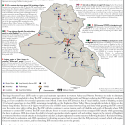 |
 |
Iraq Situation Report: July 13-18, 2016
Jul 18, 2016 - Emily Anagnostos


The Iraqi Security Forces (ISF) seeks to open and maintain operations in western Anbar and Ninewa Provinces in order to eliminate remaining ISIS strongholds in Iraq. The ISF continues operations to retake Qayyarah and Shirqat, reducing key ISIS terrain in northern Iraq, as it sets conditions for eventual operations into Mosul. Units from ISF arrived at Ain al-Asad Airbase, south of Haditha, on July 15 to launch operations to clear ISIS’s remaining strongholds on the Euphrates River Valley. These strongholds include al-Qa’im on the Syrian-Iraqi border. The loss of al-Qa’im would sever one of ISIS’s main avenues between Iraq and Syria while granting the ISF control over the entire river valley within Iraq. The ISF will also continue to secure terrain south of Haditha and north of Ramadi, where ISIS continues to contest ISF control. The ISF must allocate forces to secure recaptured areas from resurgent ISIS attacks while generating the force to advance. ISIS also retains the ability to launch spectacular attacks against soft and military targets in the vicinity of Baghdad, as witnessed by three suicide attacks at checkpoints on July 13, despite tightened security measures following the July 3 Karrada bombing. ISIS will seek to undermine anti-ISIS operations by diverting resources back to areas that the ISF previously secured, which will require forces to remain in city centers, and by stretching ISF resources thin across the ground.
Sadrist Trend leader Muqtada al-Sadr led thousands of protesters in Tahrir Square on July 15, giving usual demands for technocratic and anti-corruption reforms. The Sadrist protest remained well-ordered and disciplined, in contrast to the disorder of the protests in May and June in Sadr’s absence. Sadr issued a call on July 17 for his followers to target U.S. troops, however this rhetoric is typical for Sadr and is unlikely to inspire further action. Sadr’s affiliated political party, the Ahrar Bloc, continues to boycott the Council of Representatives, which resumed on July 12. Sadr will continue to use the protest movement in order to affect governmental reforms outside of the political process. He has shown himself capable of doing so, as the mass sit-in in March resulted in an initial push for a technocratic reshuffle. However, Sadr will need to maintain perfect order within the protest movement. Unruliness, such as that on April 30 when protesters stormed the Green Zone, will set back his efforts and cost him his leverage if Iran is forced to intervene again and quell the movement.